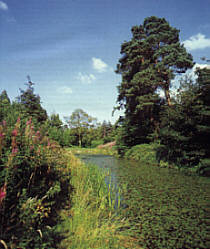Cammo

Cammo is a north-western suburb of Edinburgh, the capital of Scotland. It is south of A90, at the edge of the city, approximately 6 miles from the city centre.
Etymology
The name is Celtic in origin, but could have originated either in Scottish Gaelic or Cumbric. In the former case it would be an adjectival form of Gaelic cambas 'bay. creek'; in the latter it would be from Brittonic *cambāco-, an adjectival form of *camas 'bend in river, bay'.[1]
Cammo House
To the west of the housing area there is the former estate of Cammo House. The house was built for John Menzies in 1693, and the surrounding parkland was laid out between 1710-26 by Sir John Clerk of Penicuik (1676–1755). In 1741, the estate passed to the Watsons of Saughton at which time it was called New Saughton. The house was bequeathed to the National Trust for Scotland in 1975 but, in 1977, the house was torched twice by vandals. The house was considered unsafe and was reduced to its external ground floor walls. In 1980 the City of Edinburgh Council was gifted the estate and declared it a Wilderness Park.[2] The Council now maintain the grounds and operates a ranger service. Cammo is thought to have been the inspiration for the "House of Shaws" in Robert Louis Stevenson's novel Kidnapped.[3]

Cammo Tower (55°57′14.96″N 3°19′16.94″W / 55.9541556°N 3.3213722°W) is a 19th-century water tower for Cammo House.[4] Other remains include the ruined stable block, a formal canal, a bridge, and the lodge which now houses a small visitor centre. The grounds are now widely used by people for walking in, although other sections remain as farmland, used for cattle grazing.
References
- ^ Bethany Fox, 'The P-Celtic Place-Names of North-East England and South-East Scotland', The Heroic Age, 10 (2007), http://www.heroicage.org/issues/10/fox.html (appendix at http://www.heroicage.org/issues/10/fox-appendix.html); [1]
- ^ "Cammo Road, Cammo Estate, Cammo House, Cammo Road". Retrieved 2011-10-25.
- ^ "Cammo House". Gazetteer for Scotland. Retrieved 2008-11-27.
- ^ "Cammo Tower". Gazetteer for Scotland. Retrieved 2008-11-27.

